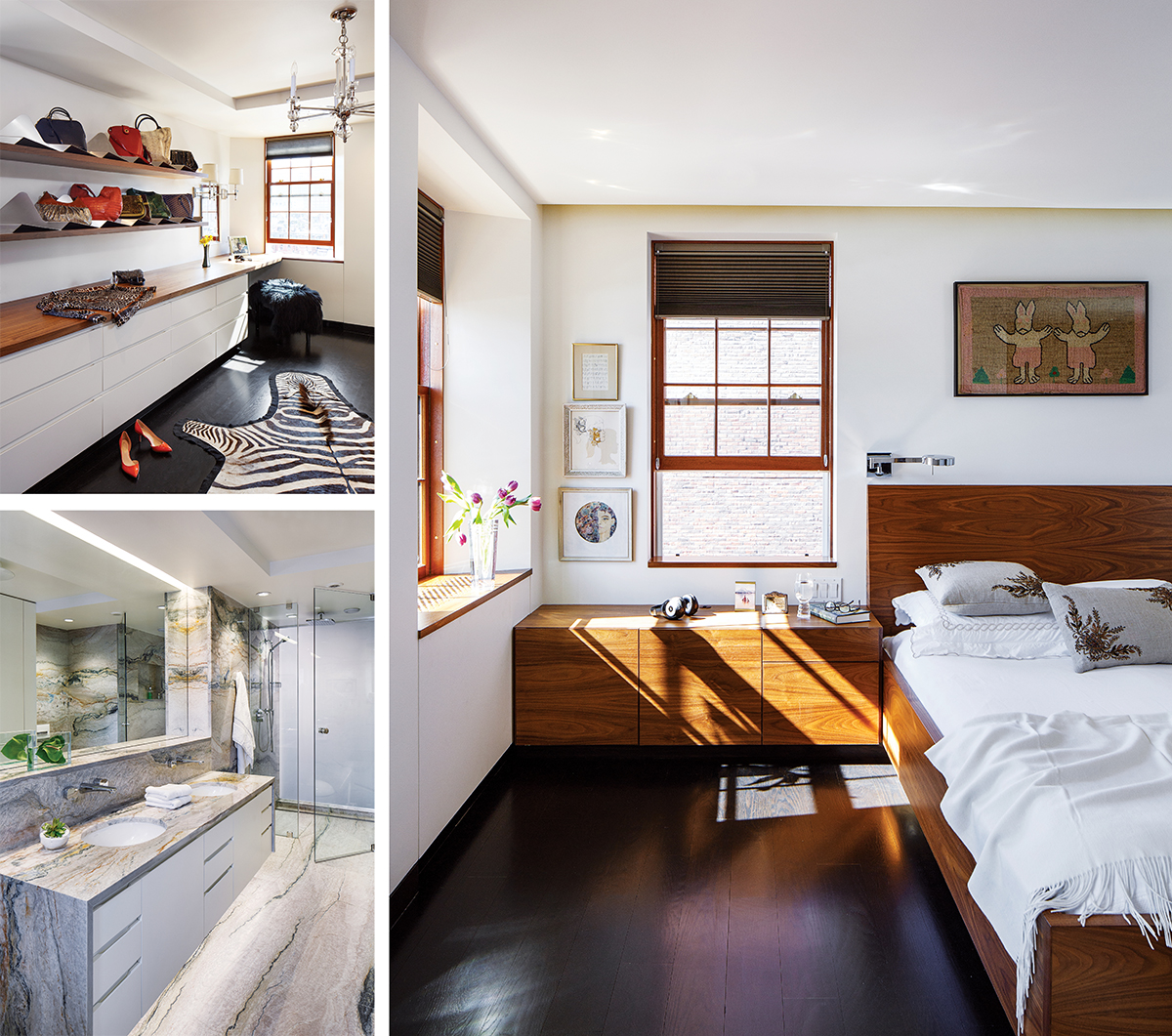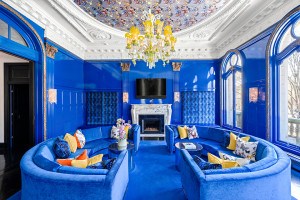Where the Art Is

Michael and Andrea Norkus relax in their kitchen, where angular columns frame the heart of their Back Bay home. / Photograph by Bob O’Connor, Styling by Kara Butterfield
Michael and Andrea Norkus accumulated a lot of things during the two-plus decades they lived in suburbia, and when their two children moved out, they knew it was time to downsize. But first, the couple had to figure out exactly which things they could let go of. “It was like a re-editing of our life,” says Michael, a management consultant. “It [was] an opportunity to start over again.” They also had to think long and hard about what they loved, wanted, and needed in a living space. The couple finally arrived at a vision: a flowing, single-floor unit—contemporary but not cold—with plenty of natural light and great views.
The 3,240-square-foot Back Bay apartment was one-third the size of their previous digs, and happened to be within blocks of their offices. But its traditional styling needed a little help to match the couple’s clean, modern aesthetic. I-Kanda Architects, a firm founded by husband-and-wife duo Isamu and Marley Kanda, spent nearly 18 months gutting and renovating the space to fit their style.
One of the architects’ earliest challenges was dealing with the two hulking columns in the kitchen that supported (but also emphasized) the unit’s low ceilings. When you encounter an element you can’t change, you can either avoid it or embrace it, says Isamu Kanda, who tends to focus on the structural elements and circulation of a space, while wife Marley tackles the materials and finishes. In this case, Kanda chose to embrace the problem, treating the structural columns like “sculptural trees” that branch out to ceiling beams. (Fitting: Kanda happens to be named after sculptor and landscape architect Isamu Noguchi, a favorite of his MIT architecture professor father.) To create a dynamic look, Kanda faceted the columns and beams into a series of origami-inspired angles—a motif that continues throughout the home. Additional faceted surfaces appear throughout, from the built-in window benches in the dining area to a custom metal display for Andrea’s designer bags in her dressing room.

From top left, the homeowners show off their wild side with this fun wall covering in the half bathroom; the couple has been collecting outsider art since the beginning of their relationship, and the first piece they purchased together still hangs in their home office. / Photographs by Bob O’Connor, Styling by Kara Butterfield
This architectural language gives the home the modernity that the Norkuses sought, while warm walnut wood accents—including panels in the otherwise crisp white kitchen; the his-and-her desk space in the office/den; and the discreet storage space in the walk-in closet—make it cozy.
There were some tricky moments: The kitchen windows, for example, looked directly into those of the adjacent residential building. To preserve privacy but get light in, Kanda frosted the windows and added a recessed skylight. Sunshine now pours straight into the kitchen.
The living areas in the home, which are linked by a series of mostly doorless passages, display the thoughtfully edited version of a marriage’s worth of stylish stuff. The couple made few new furnishing purchases for the space, instead breathing life into revived eclectic pieces from their previous, overstuffed home—from elegant Austrian Biedermeier armchairs to an antique table that once inhabited an English pub, its knotted wood still bearing the metal strike strip where matches were lit for cigars. In the great room, the walls are lined with pieces from a museum-worthy collection that’s equal parts fine art and outsider art, including works by Salvador Dalí and Sam Doyle. A slick black piano makes the room feel like a Manhattan gallery or prewar loft. Anchoring the look are two sumptuous leather club chairs that the couple bought in Germany nearly 40 years ago. In their old home, the chairs were afterthoughts—one hiding in a kid’s room. In their new home, the pair is bathed in sunlight from wide windows that span the length of the main living area, overlooking the Charles.
“It’s a different way of living,” says Andrea. “Each element is distinct and out in the open.” And, one might add, perfectly framed by the surrounding space.

Light streams through windows by the dining area’s built-in benches—sleek white units that contrast with the warm wood panels. / Photograph by Bob O’Connor, Styling by Kara Butterfield

Clockwise from left: The dressing room features streamlined wood built-ins and a custom-faceted display for Andrea’s designer-bag collection; the bedroom is tucked into the quiet, rearmost corner of the unit; the master suite boasts a generously sized quartzite-clad bathroom. / Photographs by Bob O’Connor, Styling by Kara Butterfield

With its art-lined walls, mix of eclectic furnishings, and windows facing the Charles River, the great room has the chic, airy quality of a prewar Manhattan loft. / Photograph by Bob O’Connor, Styling by Kara Butterfield

The working fireplace is filled with heart-shaped stones that the couple collects near their home on Martha’s Vineyard. / Photograph by Bob O’Connor, Styling by Kara Butterfield
Architect and Interiors I-Kanda Architects
General Contractor Brite Builders
Custom Millwork Furniture Design Services
Stone Louis W. Mian


